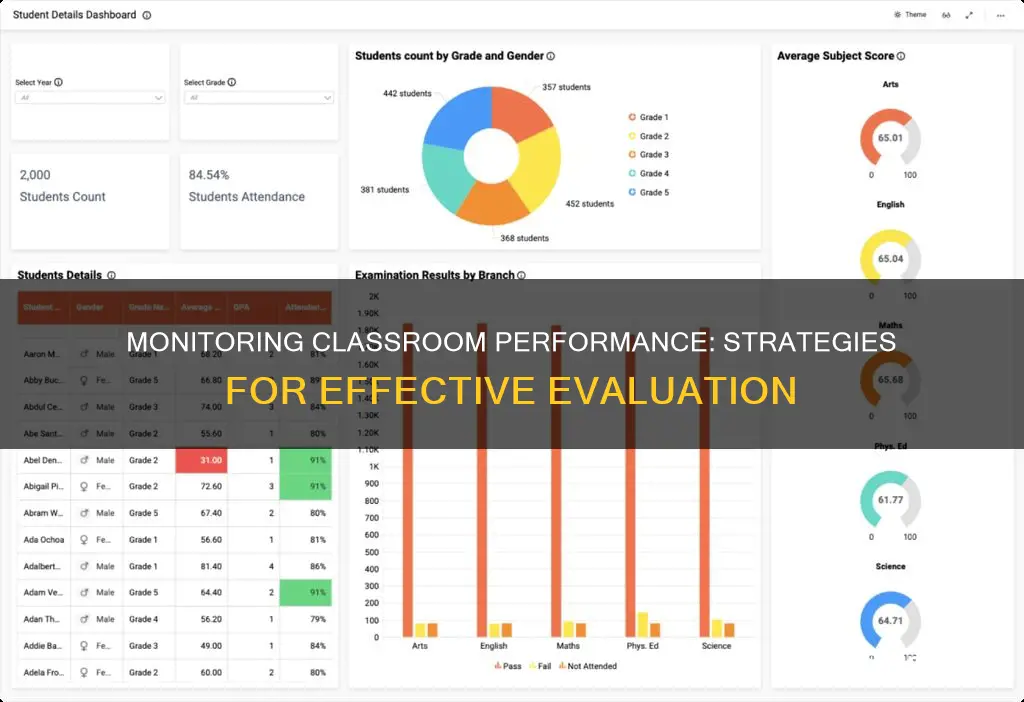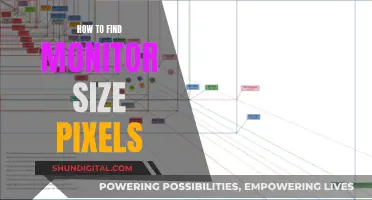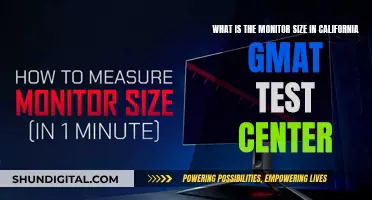
Monitoring classroom performance is an essential aspect of the educational process, offering valuable insights for both students and teachers. By tracking student progress, teachers can identify areas where their instruction methods may need adjustment and provide tailored feedback to help students improve. This process also encourages student growth, enhances differentiation opportunities, and ensures that students who are struggling receive the necessary support. There are several methods for monitoring classroom performance, including curriculum-based monitoring, frequent evaluations, observation and interaction, and formative assessments. These techniques allow teachers to gather data on student performance and make informed decisions to improve the overall learning experience.
| Characteristics | Values |
|---|---|
| Curriculum-based monitoring | Determine the teaching methods and progress of the students |
| Frequent learning | Pinpoint the areas where students are at risk |
| Observation and interaction | Understand where students lack and help them communicate effectively with teachers |
| Formative assessments | Monitor student learning progress and teaching methods |
| Automated progress detection | Keep real-time tracking of students' progress |
| Quiz and presentations | Know the students' progress and class participation |
| Collecting useful data | Gather informative student performance data |
| Improving teacher instruction | Evaluate the effectiveness of their own teaching |
| Encouraging student growth | Analyze a student's current performance level and evaluate growth throughout the year |
| Enhancing differentiation opportunities | Identify students at risk and provide intervention when required |
What You'll Learn

Curriculum-based monitoring
These tests are designed to include all the concepts taught during the year, but the questions may vary in format. This approach ensures that students are evaluated on their understanding of the material rather than their ability to memorise information. By analysing the test results, teachers can gain valuable insights into which areas of the curriculum may require additional focus or a different teaching approach.
To make curriculum-based monitoring effective, it is essential to adapt teaching methods based on student progress. If students' performance drops, teachers should be prepared to modify their teaching strategies promptly to prevent further learning gaps. This may involve reviewing previously taught material, employing different instructional techniques, or providing additional practice opportunities.
Monitor Cable Pin: Bent or Not?
You may want to see also

Frequent learning
Firstly, frequent learning helps students to develop a growth mindset and view themselves as learners. When evaluations are given frequently, students have the opportunity to see their progress over time and understand that learning is a process. This can be motivating for students, as they can see their improvements and know that they can catch up if they fall behind. It also helps students to take greater personal responsibility for their learning and become more aware of their academic performance.
Secondly, frequent evaluations allow teachers to pinpoint specific areas where students are struggling and provide targeted instruction or intervention. This ensures that students receive the support they need to succeed and helps teachers to adapt their teaching methods to better meet the needs of their students. It also enables teachers to identify students who may be at risk of falling behind and provide additional support before they reach that point.
Additionally, technology can play a crucial role in facilitating frequent learning and monitoring student progress. Platforms such as BookWidgets and Google Classroom offer a range of tools that allow teachers to create and administer evaluations, track student progress in real time, and provide personalised feedback to students. These platforms can also generate data and analytics that can help teachers identify areas where the class is struggling and adjust their teaching methods accordingly.
Overall, frequent learning is a valuable tool for monitoring student progress and improving academic outcomes. It empowers students to take ownership of their learning and enables teachers to provide targeted support and instruction to help students succeed. By incorporating frequent evaluations and leveraging technology, teachers can create a dynamic and responsive learning environment that meets the diverse needs of their students.
Identifying LCD and LED Monitors: What's the Difference?
You may want to see also

Observation and interaction
To effectively observe and interact with students, it is important to first establish a baseline to understand their current skill levels. This can be done through verbal assessments, observations, and conversations with parents or guardians. Recording these initial findings and collecting evidence of the student's work, such as samples, photographs, or videos, will help to establish a clear picture of their strengths and weaknesses.
Once a baseline is established, it is important to set clear and specific learning goals that are measurable, attainable, relevant, and time-based. These goals should be documented and shared with parents, so they can support their child's progress. It is also beneficial to create visual goal trackers for older students, so they can visually track their progress.
Throughout the year, teachers should regularly observe their students and gather evidence of their progress. This can be done through short check-in assessments, observations during free play, or photographs of students completing activities. It is important to monitor progress towards specific goals and to adjust teaching strategies if needed.
Additionally, observation and interaction can help identify students who may be at risk and need additional support. By regularly monitoring all students, teachers can ensure that no one slips through the cracks and provide interventions when required. This also helps to enhance differentiation by identifying which students require extra help or additional challenges.
Overall, observation and interaction are powerful tools for monitoring classroom performance. They provide valuable insights into student progress, allow for the adaptation of teaching methods, and facilitate meaningful interactions that can motivate and encourage students.
Monitoring Home Electricity Usage: A Continuous Guide
You may want to see also

Formative assessments
The goal of formative assessment is to provide ongoing feedback that can be used by both instructors and students to improve. Formative assessments help students identify their strengths and weaknesses and help instructors recognise areas where students are struggling, allowing them to address problems immediately. They are generally low-stakes, meaning they have low or no point value. This encourages students to focus on their learning progress rather than a final grade.
By implementing formative assessments, instructors can improve their teaching practices and better meet the needs of their students. Formative assessments provide valuable data and feedback that can be used to enhance the learning experience and ensure that students are actively engaged in their learning journey.
Ideal Image Size for Triple Monitor Setups
You may want to see also

Automated progress detection
There are several tools available that provide detailed and actionable reports on student progress, which are automatically generated and accessible online. These tools can monitor standards mastery, view individual and class results, and track students' growth over time. They can also help identify students who may need targeted intervention and allow educators to organize data across multiple classes and grade levels.
One such tool is BookWidgets, which offers a library of exercise templates that teachers can adapt with their own content. Teachers can create automatically graded quizzes, crossword puzzles, pair-matching games, and more. BookWidgets also provides valuable insights and statistics, such as the average score per question, median, maximum, and minimum scores per class, and grade evolution per student.
Another example is Progress Learning, which integrates with various features such as interactive learning, adaptive intervention, assessment and assignment builders, and independent practice. Progress Learning provides detailed reports on student progress in specific subjects and standards, session activity, and assessment comparisons. The platform also offers basic visual reports that are easy to follow, such as tracking the Galaxy Stars earned by each student.
By utilizing these automated progress detection tools, educators can gain valuable insights into students' learning journeys and make strategic adjustments to their teaching methods. This helps ensure that students are not only keeping up but also fully understanding the material.
Asus Portable Monitors: Compatible Partners for MacBook Pro 13?
You may want to see also
Frequently asked questions
Monitoring classroom performance allows teachers to collect useful data, improve their teaching methods, encourage student growth, and enhance differentiation opportunities. It also helps identify students who may be at risk and provides valuable feedback to parents.
Teachers can use curriculum-based monitoring, frequent learning assessments, observation and interaction, formative assessments, and automated progress detection systems.
Teachers can use platforms such as BookWidgets, Google Classroom, and Applied Digital Skills to track student progress and receive student work. These platforms offer features such as automatic grading, student reports, and real-time activity monitoring.
It is recommended to conduct regular formal and informal assessments to monitor student progress. This can include frequent evaluations, such as quizzes, oral tests, and written tests, to pinpoint areas where students may need additional support.
Teachers can use platforms that provide dashboards and analytics to track student progress. They can also collect student work samples, observations, and assessment results to identify areas of improvement and tailor their teaching methods accordingly.







